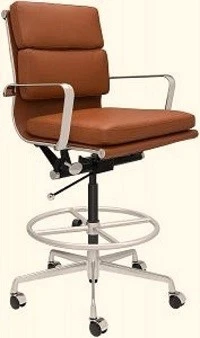Is Spinning in a Chair Bad for You. Answer is Yes. Spinning affects your balance. It moves fluid in your inner ear. This confuses your brain signals. You feel dizzy and sick. Spinning too much can cause headaches and falls. Is occasional spinning harmful? Or are there some health benefits too?
Spinning can be fun. Spinning around and around until you get dizzy. Then trying to stand up and the room is still spinning, . But is spinning in a chair bad for you?
This article explores the good and bad of spinning. We will look at the good and bad of spinning. Both in the short term if you spin for a minute and long term if you spin frequently for years. Get the facts to decide if you should keep spinning or put your feet firmly on the ground.

How Spinning Affects Your Balance and Orientation
First, let’s look at what happens in your body when you spin around in a chair or any other spinning object. Your sense of balance and spatial orientation depends on a complex system involving your inner ear, eyes, muscles and joints. This system works together to tell your brain which way is up and if you are moving. Spinning disrupts these signals.
You may also like: Best Office Chairs for Pregnant Ladies
The Inner Ear Fluid Shifts
Deep inside your inner ear are three fluid-filled semicircular canals lined with hair cells. As you spin, the fluid inside these canals rushes in the direction you are turning.
Once you stop, the fluid continues moving for a while before settling. This confuses the hair cells which send mixed signals to the brain about your orientation.
Your Eyes See a Spinning Environment
Your eyes visually perceive the room spinning around you as you rotate in the chair. However, your muscles and joints communicate to your brain that you are stationary in a seated position. This contradiction between what your eyes see and what your body feels causes disorientation and dizziness.
After-Effects Persist After You Stop
When you cease spinning signals from the inner ear hair cells, muscles and vision take some time to realign. During this period you can feel off-balance, woozy or perceive spinning sensations when completely still. This after-effect is the primary reason spinning too much can be bad for you.
Let’s look at some specific ways it impacts your body.

Dizziness, Nausea, and Motion Sickness
The mixed signals sent to your brain during and after spinning can induce temporary vertigo and disorientation. As a result, many people feel immediate dizziness when spinning.
Overstimulating the inner ear with excessive spinning can also trigger nausea and vomiting in sensitive individuals. The technical term for this is motion sickness.
Why Spinning Causes Motion Sickness
Researchers believe motion sickness is caused by overstimulation of the vestibular system in your inner ear. This stimulation does not match the inputs from your muscles and vision, which tell the brain you are not moving.
This sensory mismatch induces nausea as a protective mechanism. After spinning remain stationary with your eyes fixed on one spot until your brain interprets the signals correctly.
Headaches
Spinning may provoke headaches in prone individuals.
Several factors can contribute to spinning induced headaches:
- Neck muscle tension from prolonged strange head positions while rotating
- Squinting or eye strain trying to see while dizzy
- Dehydration from motion sickness and vomiting
- Existing migraine disorder triggered by dizziness
To prevent headaches, be sure to stop spinning if you feel pain or eye discomfort. Drink water before and after spinning and gently stretch your neck. Take over-the-counter pain relievers if needed.
Fatigue
Intense spinning can leave you feeling suddenly fatigued.
There are several explanations for spinning related exhaustion:
- Your brain works overtime trying to process disorienting signals.
- Nausea and vomiting from motion sickness are draining.
- Dizziness itself can induce fatigue.
- You expend energy tensing muscles to self-stabilize while rotating.
Listen to your body’s signals. If you feel worn out after spinning then take a rest. The fatigue should pass as your vestibular system realigns.
Risk of Injury
Spinning while seated introduces accident and injury risks especially if you spin rapidly or stand up too quickly after spinning.
Some potential injuries from spinning include:
- Falling out of the chair if you lose balance
- Muscle strains from trying to stabilize your body against momentum
- Bruises and cuts if you collide with walls or objects after spinning
- Head trauma if you fall or faint post-spinning
Follow basic safety precautions like moving furniture away from your spinning area, wearing shoes and standing gradually after prolonged spinning.

Warning Signs to Stop Immediately
Spinning should be halted right away if you experience:
- Sudden severe dizziness, nausea or vomiting
- Head, neck or back pain
- Chest tightness or heart palpitations
- Tingling or loss of sensation in limbs
- Vision changes like blurriness
- Difficulty walking or standing upright
These symptoms could signal issues like vertigo disorders, nerve damage or even heart problems. Consult a doctor if they do not resolve quickly after ceasing spinning.
Neurological Effects
How does rotating in a chair affect your brain? Research shows spinning can alter neurological activity.
Temporarily Impaired Cerebellum
The cerebellum is the area of the brain that controls coordination and balance. Studies using fMRI scans reveal that spinning decreases cerebellum activation for a period of time post-spinning.3
This cerebellum impairment explains why your motor coordination is off immediately after spinning. The effect eventually wears off as brain activity normalizes.
Changed EEG Brain Wave Patterns
Spinning also modifies your normal brain wave frequencies, as evidenced by electroencephalogram (EEG) readings. Right after spinning stops, your brain exhibits more slow theta waves. These are linked to daydreaming, light sleep and drowsiness which explains spinning-related fatigue.
Rapid beta waves associated with alertness and concentration may be suppressed initially but increase as your brain overcomes vertigo.
Increased Blood Flow to the Brain
Research shows cerebellar blood flow increases by up to 50% while spinning compared to baseline flow when stationary.
This boosts oxygen delivery to support the brain’s increased vestibular processing. Blood flow decreases rapidly once the spinning stops.
Short and Long Term Impacts
Does spinning just one time negatively affect you or do the adverse effects emerge after repeated spinning over months or years?
Here is an overview of the short and long-term health impacts.
Short Term Impacts
Spinning briefly once in a while likely causes no lasting problems in healthy people.
You may temporarily feel:
- Dizziness, nausea, headaches
- Fatigue, disorientation
- Mild lack of coordination
- Fun sensory experience
Long Term Impacts
Repetitive habitual spinning can negatively impact your health over months or years.
Such as:
- Increased motion sickness susceptibility
- Frequent vertigo spells
- Tension headaches
- Neck muscle strain
- Spinal misalignment
- Joint wear and tear
- Mild balance/coordination deficits
Conversely, regular spinning may benefit long-term brain health by boosting blood circulation and neurological activity. More research is still needed on potential lasting effects.
Who Should Avoid Spinning
While most healthy adults and kids can tolerate occasional spinning, certain groups are better off abstaining from deliberately rotating in chairs.
Those Prone to Severe Motion Sickness
If you already experience intense nausea from amusement park rides or driving on winding roads spinning will likely trigger vomiting and severe disorientation. It’s better to avoid.
Individuals with Vertigo Disorders
People with chronic vertigo conditions like BPPV, labyrinthitis, or Meniere’s disease often cannot tolerate any spinning without provoking an episode.
Anyone with a Recent Head Injury or Stroke
Those recovering from concussions or other brain injuries should avoid stimuli that disrupt equilibrium and coordination. The same applies after a stroke affecting your cerebellum or vestibular system.
Potential Benefits of Spinning
Thus far we’ve focused on the adverse effects, but is there a positive side to spinning around? Surprisingly, some research indicates potential neurological and fitness benefits.
Enhanced Brain Plasticity
Studies show spinning may promote beneficial neuroplasticity, which is the brain’s ability to reorganize itself and make new neural connections in response to stimulation.
The increased cerebellar activity and changed EEG wave patterns induced by spinning essentially “exercise” your brain’s adaptability. Spinning may also boost cognition, learning, and creativity.
Increased Vestibular System Function
With regular spinning, your brain and inner ear vestibular apparatus essentially “learn” how to quickly recover from and adapt to feelings of imbalance and vertigo.
Over time, this can strengthen overall vestibular function, improving your resilience to dizziness.
Possible Fitness Gains
Spinning stimulates your cardiovascular system. The constant motion elevates heart rate similar to light aerobic exercise. With vigorous, fast spinning, you can burn calories and work up a sweat.
More research is needed, but evidence indicates spinning may improve fitness as a form of vestibular training. Always check with your doctor before beginning any new exercise routine.

Safety Precautions for Spinning
If you choose to spin implementing some basic precautions can help reduce associated risks and side effects:
- Start slowly building up spinning speed and duration gradually over multiple sessions.
- Spin for only 1-2 minutes at a time and take frequent breaks to prevent excessive dizziness.
- Keep eyes open to minimize disorientation.
- Remain seated during and right after spinning to avoid falls.
- Keep hydrated and abstain from spinning if feeling ill.
- Adjust furnishings to create a safe spinning space away from hazards.
- Stop immediately if experiencing worrisome symptoms or pain.
- Avoid spinning before operating vehicles or hazardous machinery.
Carefully monitoring your body’s response to spinning will allow you to enjoy the activity while optimizing your safety and comfort.
Final Verdict
Unless you have a pre-existing health condition affected by dizziness, research suggests occasional, judicious spinning is not harmful for most adults and kids. Spinning briefly now and then may even strengthen brain function and stress response. But take precautions, listen to your body’s signals, and cease spinning if you feel unwell.
Frequent, prolonged spinning sessions are riskier especially if done too rapidly. They can exacerbate motion sickness, spinal strain, and headaches while providing minimal benefits. Over time, consider switching to more constructive forms of exercise and neural stimulation.
Overall, be sensible if spinning, don’t overdo it and you can likely enjoy the occasional spin without health consequences. But when in doubt, keep your feet planted firmly on the ground.
Answering the Un-Answered Questions.
Is spinning in circles bad for adults?
Most healthy adults will be fine with occasional slow spinning. However, spinning excessively fast or for more than a minute straight might cause dizziness, nausea and migraines in adults.
What happens if you spin around too much?
Excessive spinning can result in dizziness, nausea, vomiting and unsteadiness. You may feel off-balance and have poor coordination for several hours or days after stopping. In people who are sensitive to spinning, excessive spinning can cause headaches weariness and motion sickness.
What happens if you spin for 1 hour?
Spinning nonstop for an hour is likely to be risky for both kids and adults. Severe vomiting, dizziness, headaches and decreased balance/coordination are all possible side effects. Recovery could take several hours or more. This prolonged spinning is not recommended.
Can spinning cause brain damage?
There is no conclusive evidence that occasional spinning causes permanent structural brain damage or lasting cognitive deficits in healthy people without pre-existing conditions. However, repetitive spinning long-term may potentially accelerate age-related cerebellar degeneration. More research is still needed.
Can you die from spinning too much?
Death solely due to excessive spinning is highly unlikely, but could theoretically occur under extreme conditions. Possibilities include rupturing an inner ear organ and suffering permanent vertigo, provoking an underlying heart condition or spinning so fast the force causes cerebral haemorrhaging or spinal injury resulting in death. But this outcome would be very improbable.
Is spinning in circles a sign of autism?
Habitual spinning and circling are common in children with autism spectrum disorder. Up to 20% of autistic kids engage in repetitive spinning due to sensory-seeking behavior and inner ear differences.7 However, occasional spinning on its own is not necessarily indicative of autism in otherwise normally developing children.
Is spinning in circles good for you?
In moderation, spinning may benefit brain activity and stress response. But benefits seem to plateau quickly, while risks rise with excessive spinning. Frequent fast spinning can strain the body long-term.
Is spinning on your head dangerous?
Yes, spinning on your head is quite dangerous and can lead to serious injury. Blood rushes to the head with extreme gravity force during head-spinning, which can rupture blood vessels or damage the brain. Neck trauma, paralysis, and stroke are also risks if the neck twists excessively.
With a decade of experience in the chairs industry, Khalidamin brings a wealth of knowledge to Chairsvalley.com. His deep understanding of chair design, materials, and ergonomics ensures you receive expert insights. Explore the world of chairs with Khalidamin, your trusted source for a decade of expertise.

![Are Massage Chairs Good For You: Yes Or No? [A Fair Discussion]](https://chairsvalley.com/wp-content/uploads/2022/10/a-2-1.webp)







